Buffalo nickels were discontinued in 1938, and 5-cent Jefferson nickels were introduced. The bust of former American President Thomas Jefferson that appears on the coin’s obverse inspired their moniker.
The value of a 1940 Jefferson nickel depends on its grade, condition, and mint mark. Additionally, the price of this coin kind is markedly increased by various variants and errors.
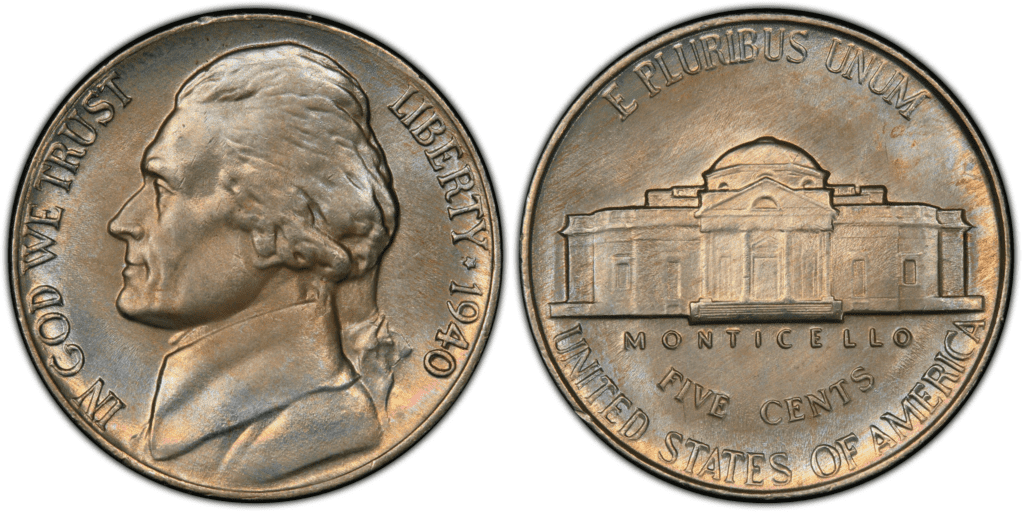
Let’s find out the value of your 1940 Jefferson nickel.
What Is the 1940 Jefferson Nickel Made Of?
Felix Schlag, a German immigrant who had recently become an American citizen, received the award for the winning design for the best nickel look. In four weeks, he created the new nickel’s obverse, based on Gilbert Stuart’s painting of Thomas Jefferson, the third president of the United States from 1801 to 1809.
There haven’t been many significant modifications to the nickel’s look. However, the same could not be said regarding its composition. Due to the demands of the military sector during World War II, there was a nickel shortage. So, Congress approved a change in the coin’s composition. At that time, these coins included silver and copper instead of nickel.
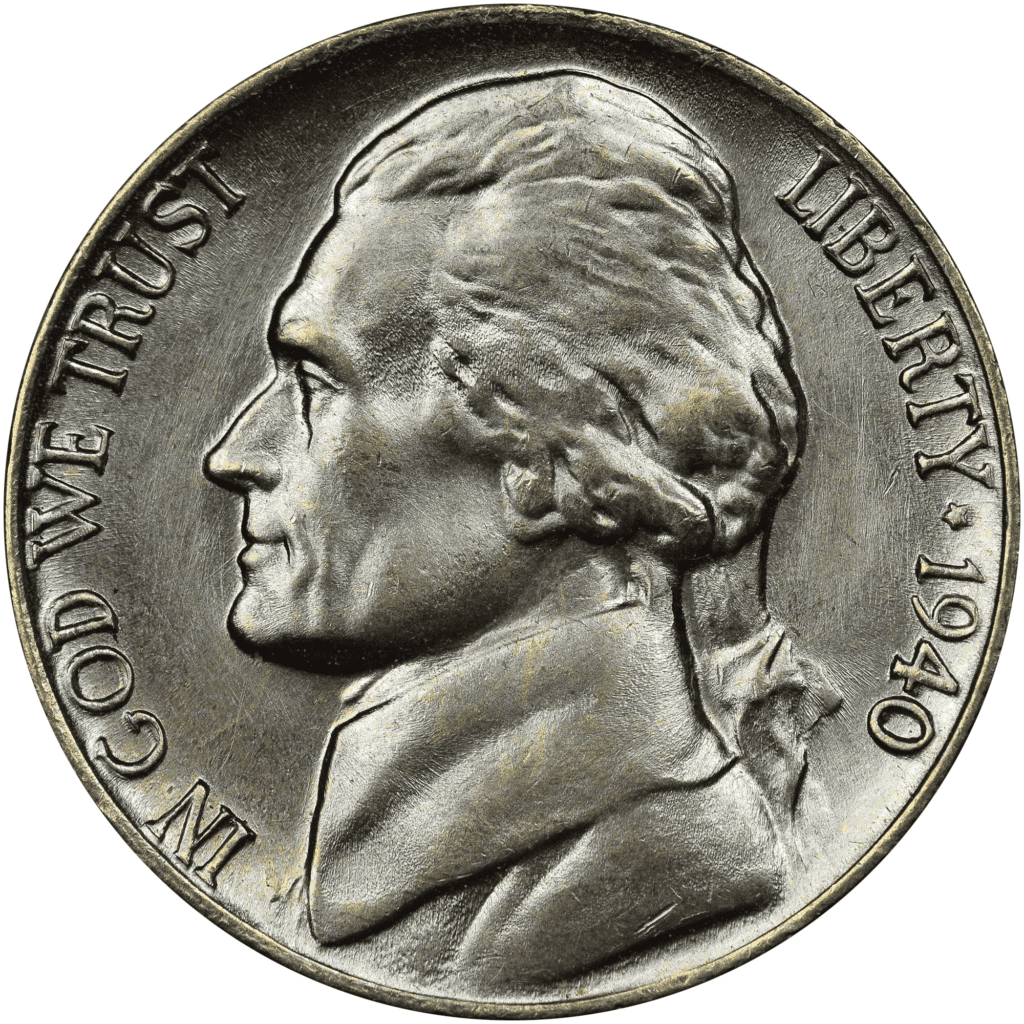
Thomas Jefferson’s profile is depicted facing left on the coin’s obverse. Jefferson has his long hair pulled back into a ponytail, the customary hairstyle at the time. His coat is finely detailed, with a high collar appropriate for that era.
The inscription IN GOD WE TRUST is on the coin’s left rim, in front of the profile. The word LIBERTY, the minting year 1940, and a tiny five-pointed star are all on the right side of the coin.
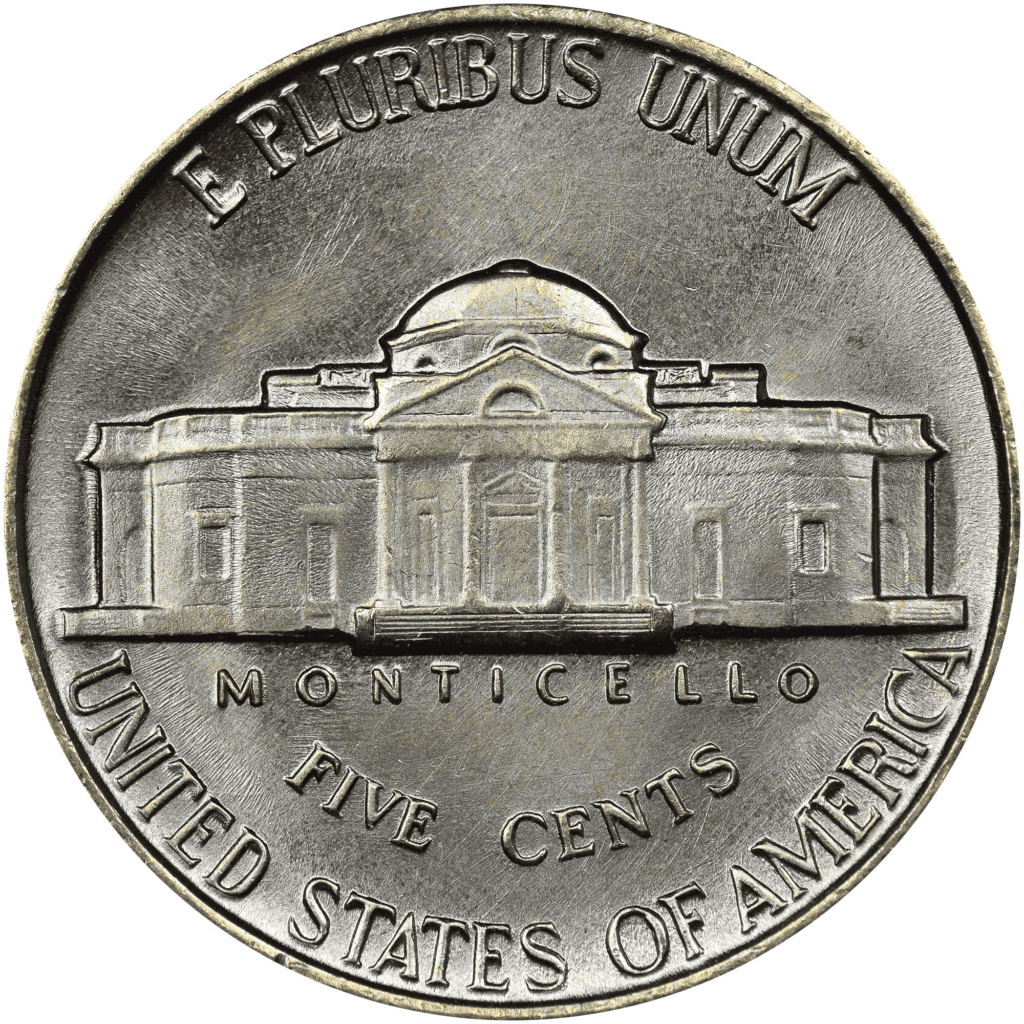
The front view of Monticello, which Jefferson built on his own initiative, is seen on the reverse. It was widely known that he drew influence from the Italian Renaissance; even the name Monticello, which means Small Mountain, is of Italian origin.
The grand structure, complete with an octagonal dome and steps leading to the porch, fills the reverse middle portion. E PLURIBUS UNUM, a Latin proverb, is written on the upper rim of this dome.
Along the bottom rim is the text UNITED STATES OF AMERICA, and above that is the denomination of FIVE CENTS. You can see the name of the residence, MONTICELLO, directly beneath the stairs. The mint mark can be located towards the right side of the Monticello mansion.
1940 Jefferson Nickel Varieties
Felix Schlag designed the 1940 Jefferson nickel has a metal composition of 75% copper and 25% nickel and a face value of $0.05 (five cents). The coin has a plain edge and weighs 5.00 grams with a diameter of 21.20 millimeters.
Here are the Jefferson nickel varieties minted in 1940:
| Variety | Mint Location | Mintage |
| 1940 D Jefferson Nickel | Denver | 43,540,000 |
| 1940 S Jefferson Nickel | San Francisco | 36,690,000 |
| 1940 P Jefferson Nickel | Philadelphia | 176,485,000 |
| 1940 Proof Jefferson Nickel | Philadelphia | 14,158 |
| Total | 256,729,158 |
These specimens and other coins made between 1938 and 1942 are from the first era. They are now considered collectible because they are over 80 years old.
1941 D Jefferson Nickel
Edge: Plain
Mint Mark: D
Place of minting: Denver
Year of minting: 1940
Face Value: $0.05 (five cents)
Price: $0.11 to $1.13 (circulated condition)
Quantity produced: 43,540,000
Designer: Felix Schlag
Composition: 75% Copper, 25% Nickel
Mass: 5 grams
Diameter: 21.20 mm
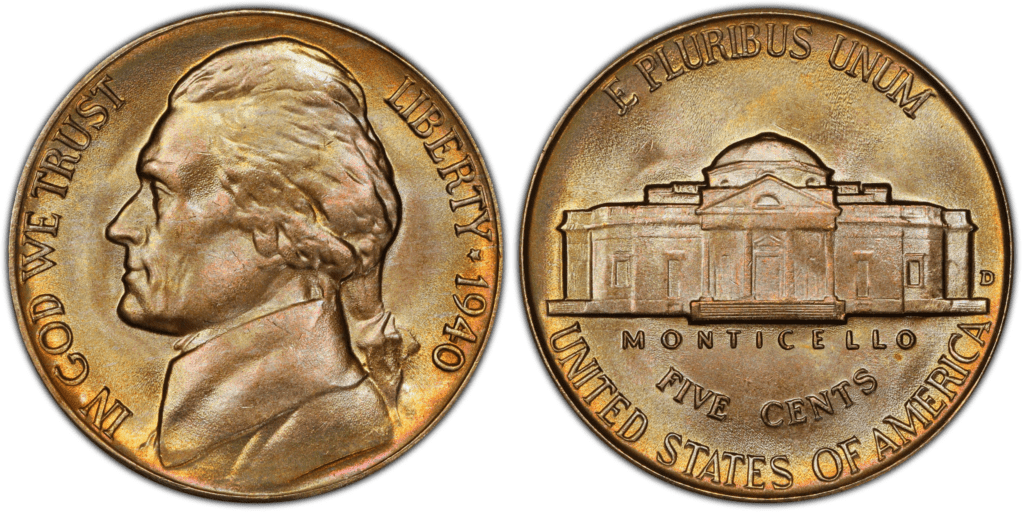
Most of the 1940 D nickels had excellent strikes and a highly appealing luster, making them exceptionally well-made coins. Gems and coins with 5FS or 6FS values are therefore abundant, as these issues are some of the most widely accessible ones with sharp steps.
This variety is one of the most reasonably priced early Jefferson Nickels because the Denver Mint produced some extremely good, fully-struck Nickels this year. PCGS certified 108 PCGS MS-67 Full Steps and 14 PCGS MS-67 non-Full Steps among the finest 1940-D Nickels.
The NGC Price Guide (as of early 2023) estimates that a circulated 1940 Jefferson nickel is valued between $0.10 and $2. But, if you sell an uncirculated specimen in pristine condition on the open market, you could get up to $125.
1940 S Jefferson Nickel
Edge: Plain
Mint Mark: S
Place of minting: San Francisco
Year of minting: 1940
Face Value: $0.05 (five cents)
Price: $0.11 to $1.13 (circulated condition)
Quantity produced: 36,690,000
Designer: Felix Schlag
Composition: 75% Copper, 25% Nickel
Mass: 5.00 grams
Diameter: 21.20 mm
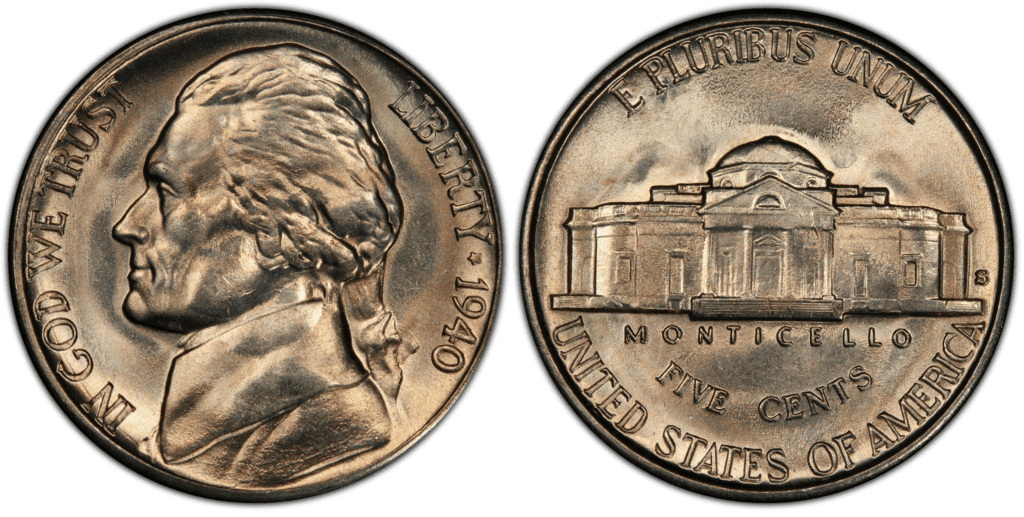
Because so many rolls were set aside then, the 1940 S Jefferson nickel is relatively prevalent in Mint State. But it can be challenging to identify a truly exceptional specimen. The majority of 1940 S nickels were manufactured inefficiently using worn dies that were clearly heavily eroded.
Another popular type is one with die-clash markings or severe die polishing to eliminate such marks. These conditions and the frequently poor luster did not result in appealing coins.
Shopping for this issue will need to be done with extreme caution. Despite these caveats, many coins have been certified as having either 5FS or 6FS due to the large volume of surviving Mint State pieces.
The PCGS has validated hundreds of copies of the 1940-S Nickel at the MS-65 and MS-66 grades, making it a highly common coin. On the other hand, superb examples are incredibly rare.
For this date/mintmark combination, many verified Mint State survivors show entire steps, indicating good striking characteristics. One MS-67 (non-Full Steps) and eight MS-67 Full Steps are among the finest examples of PCGS certified as of June 2012.
The Jefferson nickel is estimated to be between $0.10 and $1.80 (NGC Price Guide, January 2023). You can find specimens in pristine, uncirculated condition in the open market, and they could cost as much as $175.
1940 P Jefferson Nickel
Edge: Plain
Mint Mark: no mint mark
Place of minting: Philadelphia
Year of minting: 1940
Face Value: $0.05 (five cents)
Price: $0.11 to $0.85 (circulated condition)
Quantity produced: 176,485,000
Designer: Felix Schlag
Composition: 75% Copper, 25% Nickel
Mass: 5 grams
Diameter: 21.20 mm

This issue has a high mintage, making it widely available in most grades. The 5FS and 6FS coins have received enough certifications to be available to advanced collectors.
Although the example has visible die degradation and missing steps, it is appealing. Although at least two doubled-die obverse variations are known, little attention has been paid to them.
The NGC Price Guide (as of early 2023) estimates that a circulated 1940 Jefferson nickel is valued between $0.10 and $2. But, if you sell an uncirculated specimen in pristine condition on the open market, you could get up to $125.
1940 P Proof Jefferson Nickel
Edge: Plain
Mint Mark: no mint mark
Place of minting: Philadelphia
Year of minting: 1940
Face Value: $0.05 (five cents)
Price: $325 (circulated condition)
Quantity produced: 14,158
Designer: Felix Schlag
Composition: 75% Copper, 25% Nickel
Mass: 5.00 grams
Diameter: 21.20 mm
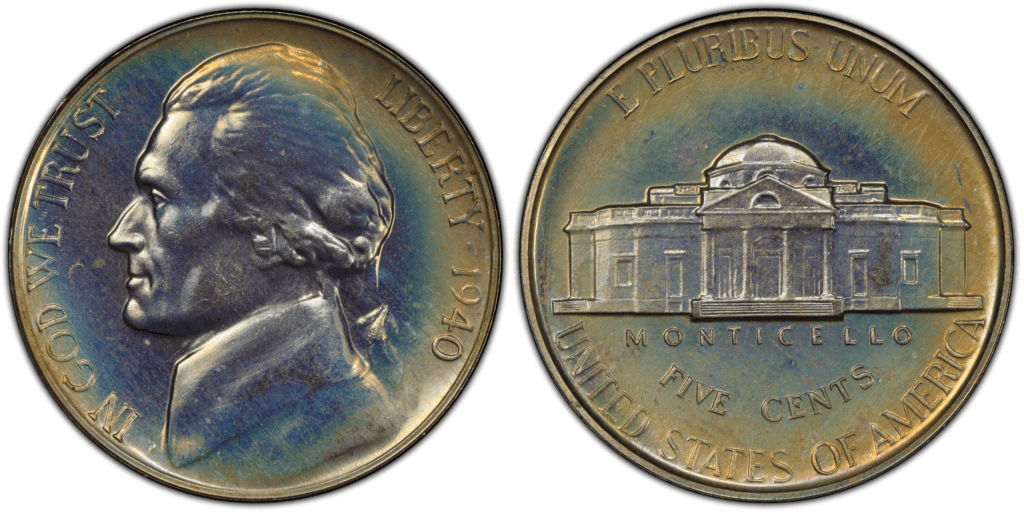
Only 14,158 proof Jefferson nickels were produced by the Philadelphia mint in 1940, which impacted their market value. A proof coin in normal condition can be purchased for as low as $18, although highly conserved coins can be expensive and cost as much as $8,000.
As usual, some examples can fetch top dollar. For instance, one collector spent $18,400 at an auction in 2005 to purchase a 1940 PR 68 Jefferson nickel.
List Of 1940 Jefferson Nickel Errors
Die Cuds and Cracks
This coin imperfection occurs when a worn-out and frequently used matrix splits close to the rim on occasion. An error-containing 1940 Jefferson nickel is worth $50 to $100. On the other side, the presence of elevated or visible anomalies like cracks on a coin’s surface raises its value. You can sell such a specimen for $10 to $50.
Off-Center Strike
An inaccurately centered die causes an off-center hump on the nickel surface. The value of this coin error depends on how far the punch is from the center. A 1940 Jefferson nickel with a 5%–10% off-center strike will cost you $10–20, while one with a 50% off-center strike will cost you $100.
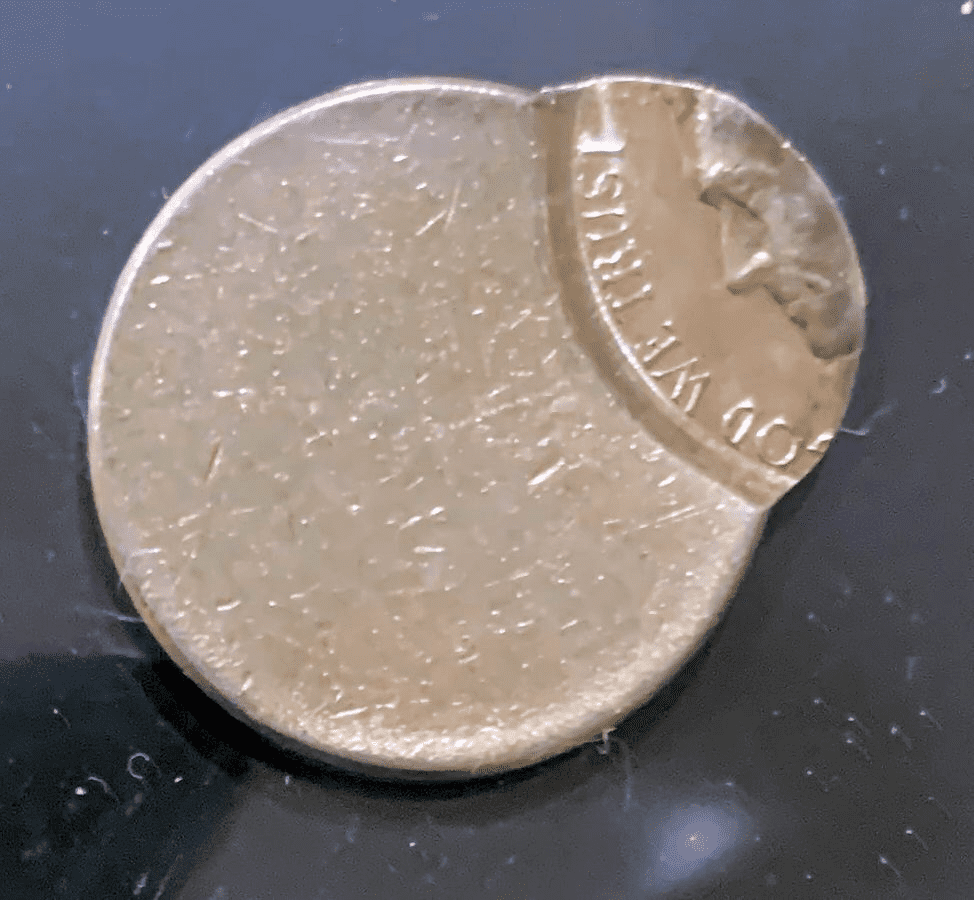
Repunched Mint Mark (RPM)
The 1940 Jefferson nickel mint markings sometimes appeared in slightly varied locations because the US Mint coiners punched each die separately. On rare occasions, you might even detect multiple hits on the mint mark. These coins range in value from $3 to $5; however, a coin with a distinctive mint mark will be more expensive.
The price range for desirable error coins with doubled or tripled mint markings, on the other hand, is $50 to $100.
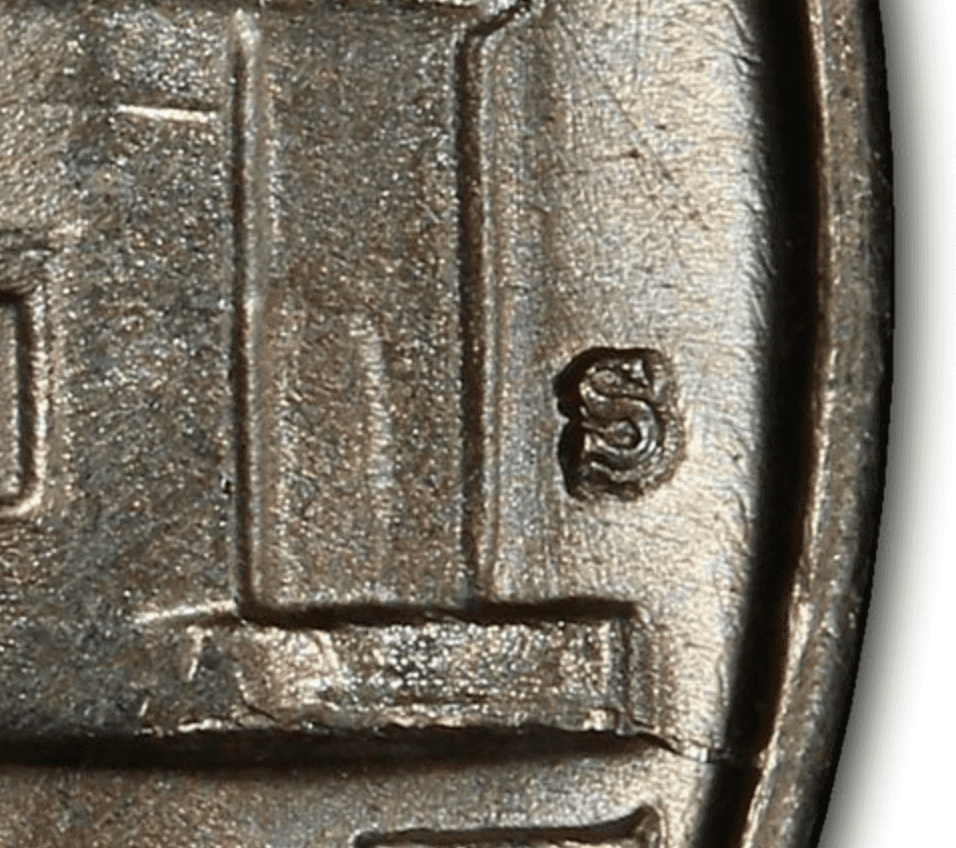
How Much Is The 1940 Jefferson Nickel Worth Today?
The 1940 Jefferson nickel is valued at $0.17 in Average Condition and can be worth up to $11 or more in Uncirculated (MS+) Mint Condition (USA Coin Book). Proof coins are worth up to $140. The NGC estimates its melt value at $1.35.
Here’s a table of 1940 nickel values chart that shows you the auction records for each variety:
| Coin | Condition | Grade | Sold date | Sold by | Value |
| 1940-D Jefferson Nickel | Superb Gem Uncirculated – Full Steps | MS 68 | May 17, 2018 | Legend Rare Coin Auctions | $21,738 |
| 1940 Proof Jefferson Nickel | Superb Gem Uncirculated – Full Step | PR 68 | November 3, 2005 | Heritage Auctions | $18,400 |
| 1940 P Jefferson Nickel | Superb Gem Uncirculated – Full Steps | MS 68 | March 3, 2016 | Heritage Auctions | $6,463 |
| 1940-S Jefferson Nickel | Superb Gem Uncirculated – Full Steps | MS 67+ | June 7, 2015 | Heritage Auctions | $5,170
|
How Does The Grading System Work?
The Sheldon Scale is used by numismatists to provide a numerical value to coins. The Sheldon Scale goes from poor (P-1) to perfect mint state (P-1) (MS-70). Coins were originally evaluated using words to reflect their condition (Good, Fair, Excellent, Etc.). Unfortunately, coin collectors and dealers had different ideas about what each of these terms represent.
Professional numismatists joined together in the 1970s and established CoinGrading standards. These numismatists now assign grades at key places on the seventy-point scale, using the most regularly utilized numeric points in conjunction with the original adjective grade. The following are the most common coin grades:
-
-
- (P-1) Poor – Indistinguishable and probably damaged; if used, must have a date and mintmark; otherwise, rather battered.
- (FR-2) Fair – Nearly smooth, but without the damage that a coin graded Poor often possesses. The coin must have enough detail to be identified.
- (G-4) Fair – Inscriptions have merged into the rims in some areas, and important elements have been mostly erased.
- (VG-8) Very Good- A little weathered, but all of the primary design elements are visible, albeit faintly. There is little if any, central detail left.
- (F-12) Good – The item is very worn, yet the wear is even, and the overall design details stand out clearly. Rims are almost completely isolated from the field.
- (VF-20) Very Fine – Moderately weathered, with some finer features still visible. The motto or all letters of LIBERTY are readable. Both sides of the coin have entire rims that are separated from the field.
- (EF-40) Extremely Fine – Gently used; all gadgets are visible, and the most important ones are bold. The finer details are bold and clear, however, light wear may be seen.
- (AU-50) Uncirculated – Slight evidence of wear on the coin’s design’s high points; may have contact marks; eye appeal should be adequate.
- (AU-58) Uncirculated Choice – Slight traces of wear, no severe contact marks, almost full mint shine, and great eye appeal.
- (MS-60) Mint State Basal – Strictly uncirculated; no indication of wear on the coin’s highest points, but an unsightly coin with reduced luster, visible contact marks, hairlines, and other flaws.
- (MS-63) Mint State Acceptable – Uncirculated, but with contact scratches and nicks, little reduced shine, but otherwise appealing appearance. The strike is weak to average.
- (MS-65) Mint State Choice – Uncirculated with great mint shine, very little contact blemishes, and exceptional eye appeal. The strike is unusually severe.
- (MS-68) Mint State Premium Quality – Uncirculated with superb luster, no obvious contact marks to the naked eye, and exceptional eye appeal. The strike is quick and appealing.
- (MS-69) Almost Perfect Mint State – Uncirculated with perfect brilliance, a sharp and appealing strike, and extremely good eye appeal. A near-perfect coin with minor imperfections in the planchet, strike, and contact markings (seen only under 8x magnification).
- (MS-70) Mint State Perfect – Under 8x magnification, there are no tiny imperfections discernible; the strike is crisp, and the coin is perfectly centered on a beautiful planchet. Rarely seen on a coin, this coin is bright and whole, with original luster and exceptional eye appeal.
-
Where To Buy Or Sell 1940 Jefferson Nickel?
The easiest way to buy or sell your 1940 Jefferson nickel is to head to online markets and auction sites like eBay, Amazon, Craigslist, or Etsy. Of course, you can also physically head to antique or coin shops, but it would be harder to find one there.
Moreover, organizations that provide professional coin grading services can also help you with your purchases. These include the Numismatic Guaranty Company (NGC) and the Professional Coin Grading Service (PCGS).
FAQs
How do I know if my 1940 nickel is worth anything?
The 1940 Jefferson nickel is valued at $0.17 in Average Condition and can be worth up to $11 or more in Uncirculated (MS+) Mint Condition (USA Coin Book). Proof coins have a value of up to $140.
Why is a 1940 nickel rare?
The rare Full Steps coins from 1940 are the most sought-after Jefferson nickels. According to PCGS and NGC, only coins with five or six steps can fall into this group.
Is a 1940 nickel made out of silver?
Due to the demands of the military sector during World War II, there was a nickel shortage. So, Congress approved a change in the Jefferson nickel’s composition. At that time, instead of nickel, these coins included silver and copper.
